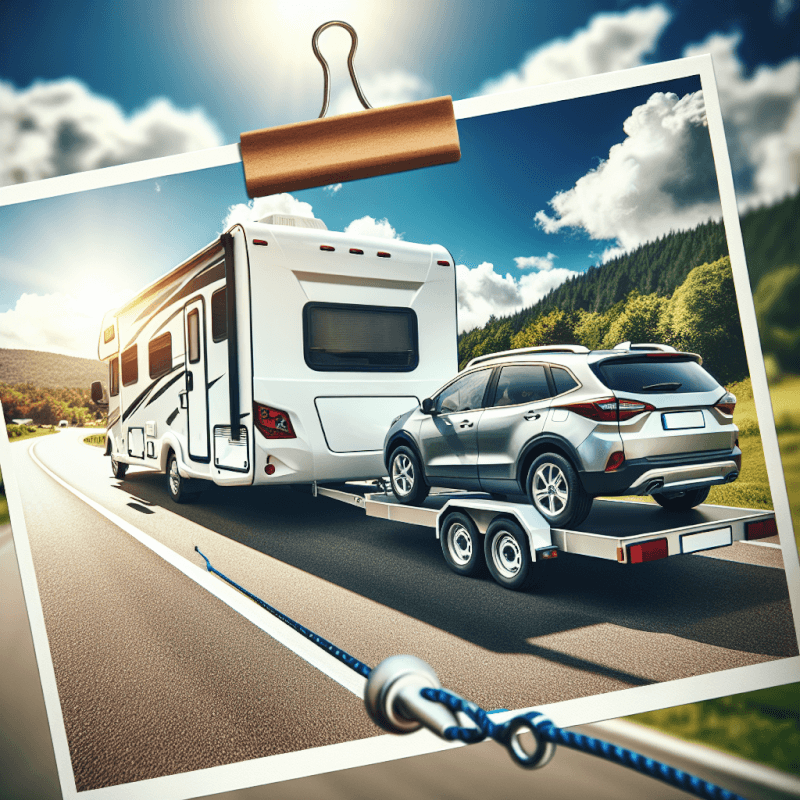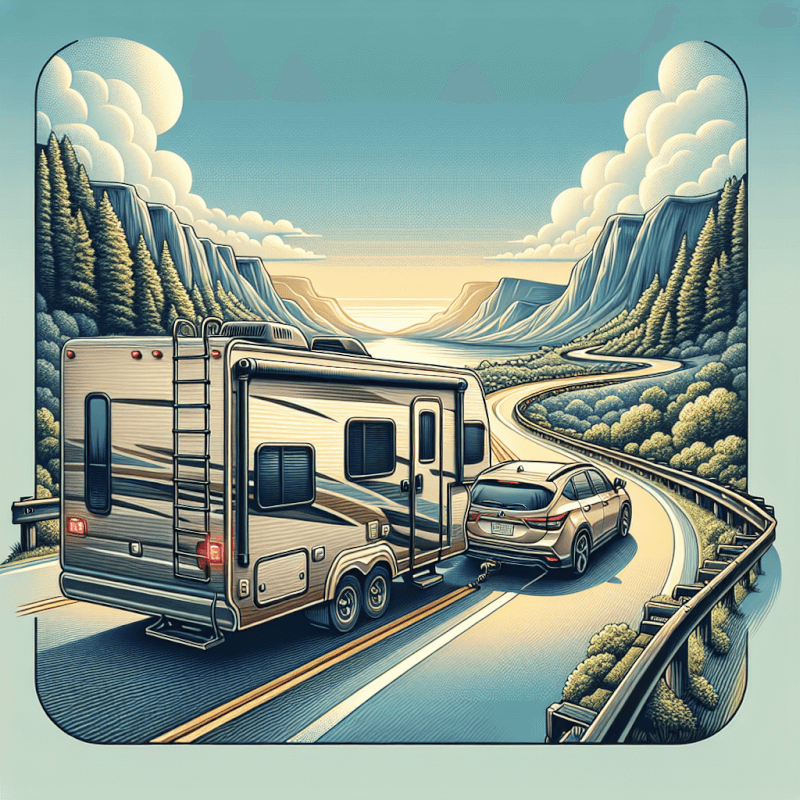Have you ever wondered if you can tow a car behind your RV and how exactly that works? Well, you’re in luck! In this article, we’re going to explore the ins and outs of towing a car behind your RV, providing you with all the information you need to know before embarking on your next road trip adventure. So, whether you’re a seasoned RV enthusiast or just starting to dip your toes into the world of recreational vehicles, sit back, relax, and let’s dive into the exciting world of towing cars behind RVs!
Types of RV Towing
Flat Towing
Flat towing, also known as dinghy towing, is a method where the towed vehicle is connected to the RV with all four wheels on the ground. This is a popular towing method for smaller vehicles and requires specific equipment such as a tow bar and baseplates installed on the towed vehicle. The advantages of flat towing include easy setup and maneuverability, as well as the ability to quickly disconnect the towed vehicle for use during stops.
Dolly Towing
Dolly towing involves using a tow dolly to tow a vehicle behind the RV. In this method, the front wheels of the towed vehicle are placed on the dolly while the rear wheels remain on the ground. Dolly towing is a suitable option for vehicles that cannot be flat towed. However, it requires additional equipment like a tow dolly and can limit the maneuverability of the RV due to the added length.
Trailer Towing
Trailer towing involves using a trailer to tow a vehicle behind the RV. In this method, the towed vehicle is loaded onto a trailer and secured for towing. Trailer towing is versatile and allows for towing a wide variety of vehicles, including larger ones. However, it requires a trailer, which adds extra weight and can affect the overall handling and fuel efficiency of the RV. Additionally, parking and maneuvering with a trailer may pose additional challenges.
Requirements for Towing a Car Behind an RV
Vehicle Weight and Towing Capacity
Before towing a car behind your RV, it is crucial to determine the towing capacity of your RV. Every RV has a specific towing capacity that indicates the maximum weight it can safely tow. Additionally, it is important to consider the weight of the towed vehicle and ensure it falls within the RV’s towing capacity. Exceeding the towing capacity can lead to dangerous situations and damage to both the RV and the towed vehicle.
Towing Equipment
To safely tow a car behind your RV, you will need the appropriate towing equipment depending on the towing method chosen. For flat towing, a tow bar, baseplates installed on the towed vehicle, and safety cables are necessary. Dolly towing requires a tow dolly with appropriate straps and safety chains. Trailer towing requires a suitable trailer with ramps or a lift system to load the vehicle and secure it properly. It is important to use high-quality towing equipment that is compatible with your RV and towed vehicle.
Braking Systems
When towing a car behind an RV, it is essential to have a functioning supplemental braking system. These systems help the RV brake effectively when towing the additional weight of the towed vehicle. Depending on the state regulations and the weight of the towed vehicle, a supplemental braking system may be legally required. Ensure that the braking system is properly installed and adjusted for optimal performance.
Safety Chains
Using safety chains is an essential safety precaution when towing a car behind an RV. These chains provide an additional level of security in case the towed vehicle becomes detached from the RV. The safety chains should be properly connected and crossed for maximum strength and security. Regularly inspect and maintain the safety chains to ensure they are in good condition and can withstand the forces encountered during towing.

Preparing Your RV for Towing
Check Your RV’s Towing Capacity
Before towing a car, it is vital to verify that your RV’s towing capacity can safely accommodate the weight of the towed vehicle. Consult your RV’s manufacturer’s manual or contact the manufacturer directly to determine the maximum weight your RV can tow. It is essential to adhere to the recommended towing capacity to ensure safe and efficient towing.
Install a Towing Hitch
To tow a car behind your RV, you will need to install a suitable towing hitch on the rear of your RV. The type of hitch required depends on the towing method you have chosen. For flat towing, a tow bar typically attaches to the RV’s rear hitch receiver. Dolly towing may require a specific type of hitch that is compatible with the tow dolly, and trailer towing will require a trailer hitch receiver. Ensure that the towing hitch is properly installed and securely attached to your RV.
Adjust the RV’s Towing Height
Properly adjusting the towing height of your RV is essential for safe and level towing. The height of the hitch receiver should be adjusted to match the height of the towed vehicle, ensuring that the RV and the towed car are level when connected. This helps maintain stability and prevents excess strain on the towing equipment. Use appropriate hitch risers or lowerers to achieve the correct towing height and consider professional assistance if needed.
Ensure Properly Maintained Tires
Before towing a car behind your RV, inspect and maintain the tires on both your RV and the towed vehicle. The RV’s tires should be in good condition, properly inflated, and have sufficient tread depth. Check the towed vehicle’s tires for any signs of wear or damage and ensure they are properly inflated. Maintaining well-maintained tires on both vehicles helps ensure safe and smooth towing, reducing the risk of blowouts or other tire-related incidents.
Preparing Your Car for Towing
Check Your Vehicle’s Towing Capability
Not all vehicles are suitable for towing behind an RV. Refer to your vehicle’s owner manual or consult with the manufacturer to determine if your car is towable and what precautions are necessary for towing. Ensure that your vehicle can handle the stress of being towed, including the brunt of wind resistance and the added strain on the transmission.
Positioning the Car on the Tow Dolly or Trailer
If you are using a tow dolly or trailer for towing, it is vital to properly position the car to ensure stability during towing. For tow dollies, the front wheels of the car should be securely mounted on the dolly and properly tightened. With trailers, carefully position the towed vehicle ensuring it is centered on the trailer and securely fastened according to the manufacturer’s instructions. Proper positioning guarantees safe and secure towing without compromising the balance of the RV.
Securing the Car
To prevent any movement or damage during towing, the towed vehicle must be securely fastened to the towing equipment. For flat towing, use a tow bar with baseplates installed on the car to securely attach it to the RV. Double-check that all connections are properly tightened and locked. When using a tow dolly or trailer, use appropriate straps and chains to secure the car, ensuring they are tightened and in good condition. Regularly inspect the connections during stops to ensure they remain secure.
Disconnecting Battery Cables
When towing a car behind your RV, it is generally recommended to disconnect the car’s battery cables. This helps prevent unnecessary drain on the battery and potential electrical issues in the towed vehicle. Refer to your vehicle’s owner manual for specific instructions on safely disconnecting the battery cables. Keep in mind that some vehicles may require additional steps, such as engaging the steering lock or setting the transmission in neutral, to ensure safe towing.

Operating Tips While Towing
Know and Follow Towing Speed Limits
Different states and provinces may have specific speed limits for vehicles towing trailers or other towed vehicles. It is crucial to familiarize yourself with the towing speed limits and strictly adhere to them to ensure your safety and the safety of others on the road. Driving at a reasonable and controlled speed allows for better control of the RV and reduces the risk of accidents or mishaps while towing.
Consider Additional Length and Weight
Towing a car behind an RV increases the overall length and weight of the RV, affecting its handling characteristics. It is important to consider these factors and make any necessary adjustments to your driving habits. Be mindful of the increased length when changing lanes, making turns, or maneuvering through tight spaces. Allow for additional braking distance, and be aware of the added weight affecting acceleration and turning capabilities.
Maintain a Safe Distance
To ensure safe towing, always maintain a safe distance between your RV and other vehicles on the road. Remember that your braking distance may be longer while towing, so allowing for extra space between your RV and the vehicle in front of you is crucial for safe stopping. Consider the weight and length of your RV and adjust your following distance accordingly.
Adjust for Turns and Braking
When towing a car behind your RV, it is important to make adjustments for turns and braking. Take wider turns to accommodate the extended length of your RV plus the towed vehicle. Braking should be done gradually and earlier than usual to account for the extra weight being towed. Avoid sudden maneuvers that could put stress on the towing equipment or compromise the stability of the RV.
Legal Regulations and Requirements
State-Specific Towing Laws
Each state has specific regulations regarding towing a car behind an RV. It is important to familiarize yourself with the towing laws of the states you will be traveling through to ensure compliance. Pay attention to requirements such as speed limits for towing, the necessity of supplemental braking systems, and any additional permits or documentation required for towing.
Towing Related Licensing and Registration
In addition to state-specific laws, there may be licensing and registration requirements related to towing a car behind an RV. Some states may require a specific endorsement or license classification on your driver’s license to legally tow a vehicle. Likewise, the towed vehicle may require separate registration or special license plates. Check with the appropriate authorities or DMV to understand the licensing and registration requirements for towing.
Insurance Coverage
Before towing a car behind your RV, review your insurance coverage to ensure it provides adequate protection. Contact your insurance provider to discuss potential changes or additions to your policy, as towing a car may require additional coverage. It is crucial to have insurance that covers both the RV and the towed vehicle in the event of an accident or other unforeseen circumstances. Understanding your insurance coverage helps provide peace of mind during your travels.

Potential Challenges and Considerations
Driving Difficulties
Towing a car behind an RV can introduce additional challenges while driving. Maneuvering, parking, and navigating tight spaces may require extra caution and skill. It is important to be patient, plan your routes accordingly, and allow for additional time during your travels to accommodate any driving difficulties that may arise.
Fuel Efficiency
Towing a car behind your RV can impact fuel efficiency. The added weight and wind resistance can cause a decrease in fuel economy. Consider this factor when planning your trip and budgeting for fuel costs. Monitoring fuel consumption and adjusting your driving habits, such as maintaining a steady speed and avoiding unnecessary idling, can help mitigate the impact on fuel efficiency.
Parking Limitations
When towing a car behind your RV, parking can become more challenging. The added length of the RV and the towed vehicle requires larger parking spaces or specific RV-friendly parking areas. Research and plan ahead to identify suitable parking options along your route or at your intended destinations. If necessary, utilize campgrounds or RV parks that offer adequate parking space for RVs with towed vehicles.
Potential Damage to Towed Vehicle
While towing a car behind your RV, there is always a risk of damage to the towed vehicle. Road debris, uneven terrain, and sudden movements can potentially cause scratches, dents, or other damage to the towed car. Regularly inspect the towed vehicle during stops to ensure no damage has occurred. Take necessary precautions such as avoiding gravel roads or rough terrain when possible to minimize the risk of damage.
Pros and Cons of Towing a Car Behind an RV
Accessibility and Convenience
Towing a car behind an RV offers greater accessibility and convenience during travels. Having a separate vehicle allows for easier exploration and transportation at your destination without the need to unhitch the RV. It provides the flexibility to run errands, sightsee, or go on off-road adventures with the towed car, enhancing your overall travel experience.
Flexibility and Independence
Towing a car behind an RV provides a sense of flexibility and independence. It allows you to detach the towed vehicle and use it for local transportation while leaving the RV parked at your campsite. This gives you the freedom to explore remote areas, visit attractions, or stock up on supplies without the need to maneuver the RV through unfamiliar terrain.
Increased Fuel Consumption
One of the drawbacks of towing a car behind an RV is the increased fuel consumption. The added weight and wind resistance can cause a decrease in fuel efficiency, leading to additional fuel expenses. It is important to consider this factor when planning your trip and budgeting for fuel costs.
Added Maintenance and Costs
Towing a car behind an RV can result in additional maintenance and costs. The towing equipment, such as tow bars, tow dollies, or trailers, may require regular inspection, maintenance, and potential repairs. Additionally, the wear and tear on the towed vehicle can increase maintenance and repair costs over time. It is important to factor in these additional expenses when considering towing a car behind your RV.

Alternative Options to Towing
Renting a Car at Your Destination
If the idea of towing a car behind your RV seems cumbersome, renting a car at your destination is a viable alternative. Many rental agencies offer temporary vehicle rentals, allowing you to have local transportation without the need for towing. This option eliminates the need for additional towing equipment and can potentially be more cost-effective for short trips or infrequent use.
Using a Tow Truck Service
In situations where towing a car behind your RV is not practical or possible, utilizing a tow truck service is an alternative solution. A tow truck can transport your car separately to your desired destination, allowing you to focus solely on driving your RV. This option eliminates the need for towing equipment and provides peace of mind knowing that your vehicle is safely transported.
Conclusion
Towing a car behind an RV offers convenience, flexibility, and accessibility during your travels. Whether you choose flat towing, dolly towing, or trailer towing, it is essential to understand the requirements, safety precautions, and legal regulations associated with towing. Properly preparing your RV and towed vehicle, following operating tips, and considering potential challenges will help ensure a safe and enjoyable towing experience. While there are pros and cons to towing a car behind an RV, exploring alternative options such as renting a car or using a tow truck service can provide flexibility when towing is not ideal. Ultimately, the decision to tow a car behind your RV should be based on your specific needs, preferences, and the nature of your travel plans.



